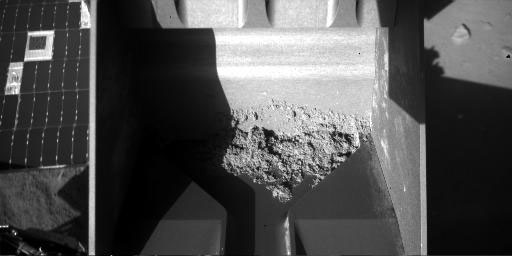Mars Dirt Found Surprisingly Sticky

The icy dirt mixture that NASA's Phoenix Mars Lander is trying to sample is surprisingly sticky, mission scientists learned this weekend, as they tried to deliver a clump to one of the craft's instruments.
The difficulties of delivering the sticky dirt, thought to be a mixture of water ice and dust and other unknown minerals similar to terrestrial soil, but without microbes, to one of the ovens in Phoenix's Thermal and Evolved-Gas Analyzer (TEGA) are forcing scientists to delay those plans and dig for another sample of dry dirt instead. The lander analyzed its first dry dirt sample about a month ago.
"While we continue with determining the best way to get an icy sample, we intend to proceed with analyzing dry samples that we already know how to deliver," said Phoenix principal investigator Peter Smith, of the University of Arizona.
Phoenix mission controllers have been scraping up samples from the subsurface rock-hard ice layer and testing out methods to deliver an icy sample to TEGA since mid-July. TEGA heats up the samples and then analyzes the vapors they give off to determine the sample's composition.
Phoenix has been analyzing samples of the Martian regolith since its landing on May 25 and looking for signs of potential habitability in the planet's past.
The Phoenix team tried two methods of picking up and delivering a sample of the icy dirt over the weekend. In both cases, most of the sample stuck inside the lander's inverted scoop, at the end of its 7.71-foot (2.35-meter) robotic arm.
"It has really been a science experiment just learning how to interact with the icy soil on Mars ? how it reacts with the scoop, its stickiness, whether it's better to have it in the shade or sunlight," Smith said.
Get the Space.com Newsletter
Breaking space news, the latest updates on rocket launches, skywatching events and more!
Images returned early Monday showed a small amount of soil reached the screened opening of the target TEGA oven, but other data from the spacecraft indicated that not enough of the dirt had been funneled into the oven to begin an analysis.
The Phoenix team encountered the same problem with the first dirt sample they delivered to TEGA on June 10. After several trials of vibrating the machine, the dirt fell into the oven. The team tried to use vibration to deliver the icy sample on Sunday as well, although this time they used a motor to vibrate the scoop while holding it upside down over the oven.
Join our Space Forums to keep talking space on the latest missions, night sky and more! And if you have a news tip, correction or comment, let us know at: community@space.com.

Andrea Thompson is an associate editor at Scientific American, where she covers sustainability, energy and the environment. Prior to that, she was a senior writer covering climate science at Climate Central and a reporter and editor at Live Science, where she primarily covered Earth science and the environment. She holds a graduate degree in science health and environmental reporting from New York University, as well as a bachelor of science and and masters of science in atmospheric chemistry from the Georgia Institute of Technology.









